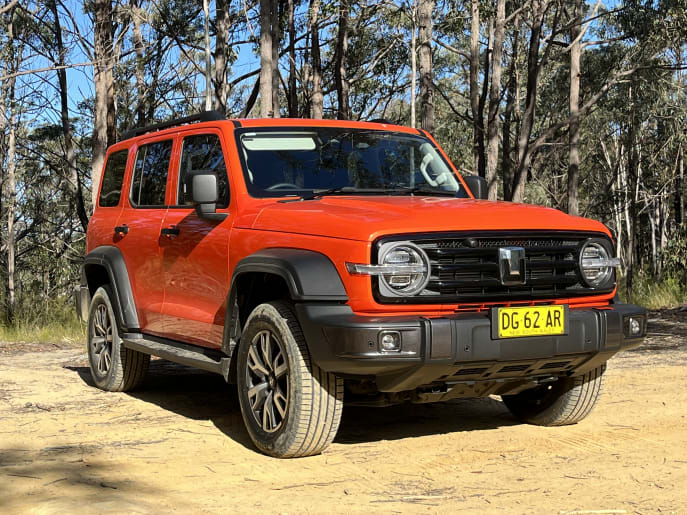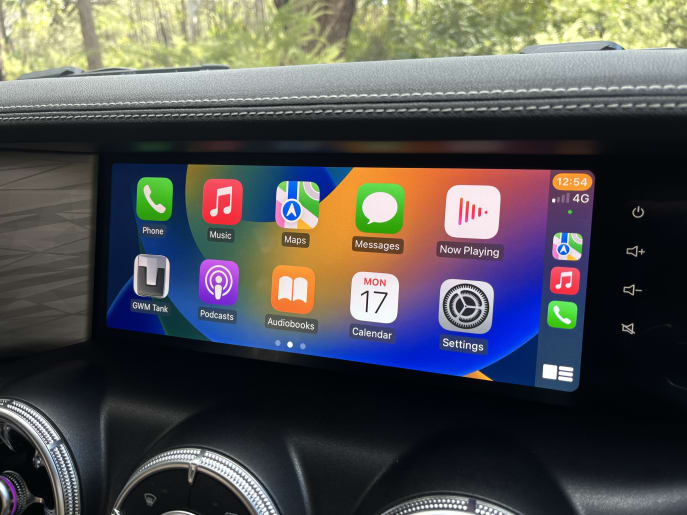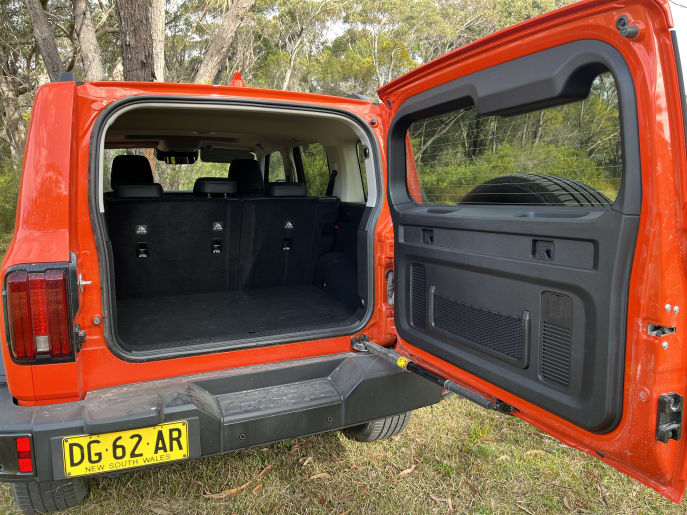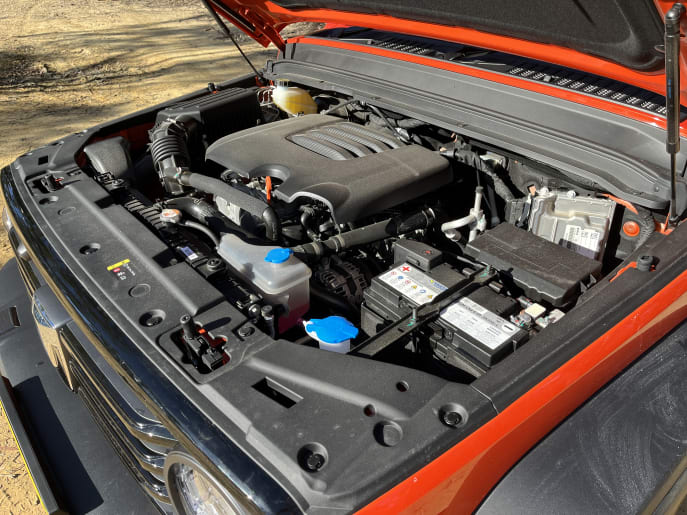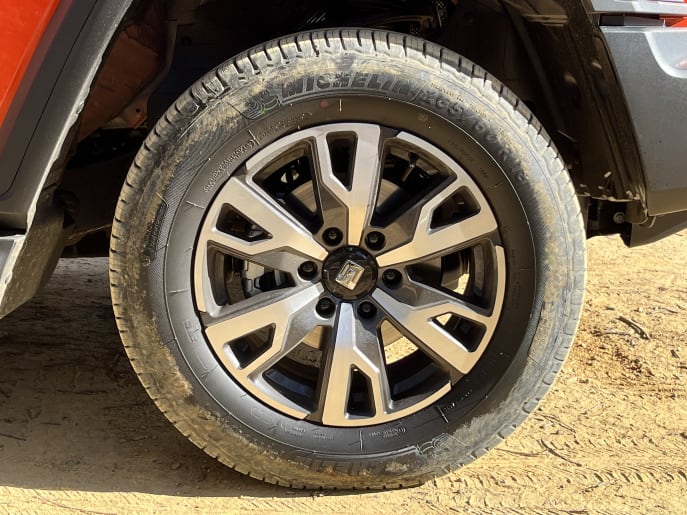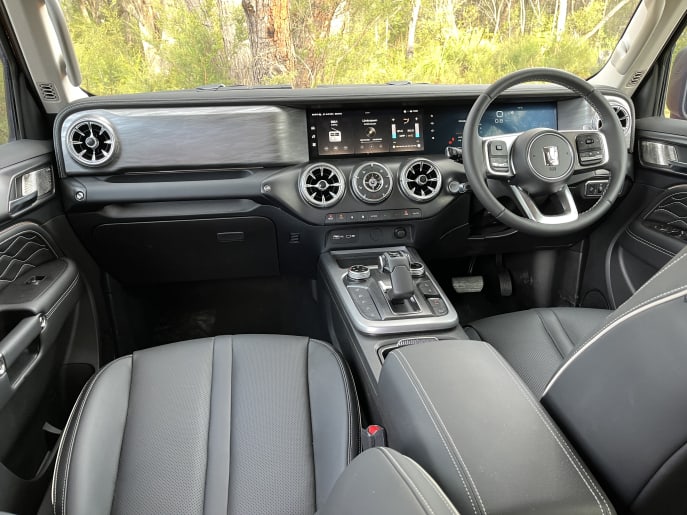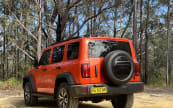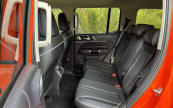A lot of people want a capable 4WD wagon, but high prices have put many off.
GWM (Great Wall Motors) is hoping to capitalise on that desire with its new petrol-only Tank 300, a 4WD wagon purpose-built for off-road use, but one that is packed with standard features and has a driveaway price around $46,990 (for the Lux variant) and $50,990 (for the Ultra, which we tested).
Going by that GWM-provided pricing, the Tank 300 is about $20,000 cheaper than some petrol-powered rivals, such as the Jeep Wrangler and the Land Rover Discovery Sport, and any similarly-priced diesels are entry-spec variants.
But is the Chinese-made Tank 300 any good?
Price and features of the 2023 GWM Tank 300 Ultra petrol
As mentioned, there are two variants in the Tank 300 petrol-only range: the Lux (with a driveaway price of $46,990) and the Ultra (with a driveaway price of $50,990).
The petrol-only variants are up to $10,000 cheaper than their hybrid stablemates.
The Tank 300's standard features list includes a 12.3-inch touchscreen multimedia system (with Apple CarPlay & Android Auto), Nappa leather accented seats, heated and cooled (front) seats, power adjustable driver’s seat (eight-way) with lumbar adjustment and massage, nine-speaker premium audio, 64-colour ambient lighting, auto-dimming rear-view mirror, wireless charging, 12V and 220V power outlets, front and rear diff locks, and 18-inch alloy wheels.
It has LED headlights and taillights, front and rear USB ports, sunroof, side steps, roof rails, seven airbags (including centre), Autonomous Emergency Braking (AEB) and forward collision warning, lane departure warning, lane keep assist, lane centre keep, emergency lane keep, adaptive cruise control, traffic sign recognition, rear cross traffic alert with brake, tyre pressure monitoring, front parking sensors and rear parking sensors, 360-degree around-view camera, all-terrain mode selection, turn assist, transparent chassis function and more.
The GWM Tank 300 is available with five exterior paint jobs: Fossil Grey is no-extra-cost standard, but Lunar Red, Pearl White, Crystal Black or Dusk Orange, each costs $595. Our test vehicle was a like-it-or-loathe-it Dusk Orange.
This is a straight up and down, boxy 4WD with big wheel arches and protruding side steps and, depending on the variant you buy, the interior will either have Comfort-Tek leather seating (Lux), or Nappa leather seating (Ultra) and beyond those soft-touch surfaces the Tank 300 has a practical and comfortable interior.
The 12.3-inch touchscreen multimedia system, with Apple CarPlay & Android Auto, is easy enough to use even if the English-as-a-second-language wording on some of the driving-mode explanations is a bit off-target every now and again.
The audio system is nine-speakers in the Lux and Ultra, but the Ultra's is tagged 'Premium'.
There's also wireless charging, front and rear USB ports, as well as 12V and 220V power outlets.
This vehicle has five seats: bucket-style seats up front for driver and front passenger (both okay, but not great in terms of support and comfort), and a three-seat bench-style second row in a 60:40 split configuration – also okay, but not great.
The seats are Nappa leather accented, heated and cooled (upfront), and the driver gets an eight-way power-adjustable perch (with lumbar adjustment and massage).
Cargo space is a listed 400 litres when the second row seats are in use, and 1635 litres when that second row is stowed away.
The 64-colour ambient lighting adds a nice touch of disco to your night-time driving.
The Tank 300 petrol has a 2.0-litre turbo-charged four-cylinder petrol engine, producing 162kW at 5500rpm and 380Nm from 1800 to 3600rpm.
It has an eight-speed torque-converter automatic transmission (the Tank 300 hybrid has a nine-speed auto) and a part-time four-wheel drive system with 4WD high range and 4WD low range for off-roading.
The Tank 300 Ultra petrol has a listed fuel consumption of 9.5L/100km and uses regular unleaded fuel.
On our test – including a day of 4WDing – we recorded 10.1L/100km from fill to fill.
The Tank 300 has a 75-litre fuel tank so, going by that 10.1L/100km fuel figure, you could reasonably expect a driving range of about 740km from a full tank.
Note: Remember to drop 30km to 50km off any calculated fuel-range figure for a better idea of your vehicle’s actual safe touring range. Also, remember that numerous other factors affect fuel consumption and consequently impact touring range, including how much weight you have onboard (passengers, camping gear etc), whether your vehicle is fitted with any aftermarket equipment (bullbar, spare-wheel carrier, etc), whether you are towing (a camper-trailer, caravan, or boat etc), what your vehicle's tyre pressures are, and what conditions you’re driving in (desert heat, mountain cold etc).
The Tank 300 has the maximum five-star ANCAP safety rating from testing in 2022.
It has seven airbags and a comprehensive suite of driver-assist tech including AEB, forward collision warning, lane departure warning, lane keep assist, lane centre keep, emergency lane keep, adaptive cruise control (didn’t work for me), traffic sign recognition, rear cross traffic alert (RCTA) with brake, tyre pressure monitoring, front and rear parking sensors, and a 360-degree around-view camera.
The Tank 300 has a seven-year/unlimited kilometre factory warranty, five years roadside assistance and five years capped price servicing.
At time of writing, the prices and servicing intervals were not available.
Driving the 2023 GWM Tank 300 Ultra petrol
The Tank 300 is a nice surprise for many reasons.
It’s quiet and refined on-road – a definite substantial improvement over previous GWM SUVs.
The petrol engine is a lively unit, steering has a sporty feel about it and is precise enough for easy driving in the city, suburbs and on the highway.
Ride and handling is generally composed. It can feel a bit floaty at times, with some body-roll during livelier turns but otherwise this 4WD feels stable and planted.
NVH (noise, vibration and harshness) levels are effectively subdued, though some wind rush around the big wing mirrors can be heard from inside the cabin.
Visibility is reasonable but a bit pinched in places, which is not unexpected, considering the Tank 300 has a cabin structure similar to that of a Wrangler. The big engine lid can somewhat impact the driver’s forward vision, and that’s why, when you’re 4WDing, the Tank 300’s transparent chassis function* comes in handy. (* More about that soon.)
The Tank 300 does have a few quirks…
Quirk 1. The lane keep assist is too harsh and too pre-emptive in its application – abruptly jerking the vehicle back into line whenever it deems you have drifted too far off-centre.
Quirk 2. The auto stop-start system is quite harsh, exhibiting a definite abrupt engagement. Also, at times there is a disconcerting amount of lag between when you put foot pressure on the accelerator and the car actually re-starts – far from ideal when you need quick off-the-mark momentum to safely merge with traffic from a stoplight, or you need to get going after a lengthy pause at a roundabout.
The first time I switched off the auto stop-start system during a brief pause at a red light the Tank froze – the engine was still on, but the vehicle simply wouldn’t move. I hadn’t inadvertently engaged the park brake or put the vehicle into neutral or anything else that would keep me at a standstill. But there I was – static. Not ideal, especially when the light then turned green and I couldn’t move until I’d switched the car itself off and back on again to get moving. Now, I may have only been static for five to 10 seconds but in Sydney traffic that’s an eternity.
Quirk 3. The indicator stalk requires incremental, seemingly minute differences in the amount of pressure the driver needs to apply to it in order to signal a full right- or left-hand turn or a simple lane-change manoeuvre. The indicator would often stubbornly stay on after I’d signalled a lane-change, no matter how quickly or softly I hit the stalk. Annoying, and possibly dangerous if the drivers behind or beside you on the highway think you’re changing lanes or about to turn.
I eventually got the knack of applying just the right mount of pressure for indicating a lane-switch, but that indicator is bloody sensitive.
Quirk 4. I could never get adaptive cruise control to work. I’ve since found out that it may have had something to do with what driving mode I was in – but that shouldn’t have mattered!
None of those niggles are deal-breakers, but you should be aware of them.
The Tank 300 handled the dirt track to our 4WD test site with ease. This route is scarred with light to medium corrugations, severe ruts and deep potholes, so it’s not a stroll in the park for any standard 4WD, but this GWM wagon, in 4WD high-range, did well and was only ever slightly rattled when we drove through a section of deeper wheel ruts and potholes where modified 4WDs had ripped up the track.
The Tank 300 is well suited to low-range 4WDing. It may not have a ton of torque on tap (380Nm), but that torque is available across a decent rev range and this 4WD makes efficient use of what it does have.
The off-road driving modes – including Mud/Sand, Rock, Mountain, and Pothole – seem well calibrated to fit the demands of different terrain – although I didn’t get to try out Snow. When you engage some of the modes it will lock diffs where appropriate.
Low-range gearing is decent and, with its front and rear diffs locked, the Tank 300 easily did everything asked of it.
As mentioned, visibility is impacted in places due to the cabin build style, but that’s not such an issue when you’re 4WDing at very low speeds. However, the Tank 300 has a clever piece of tech that goes some of the way to improving driver visibility: it has a transparent chassis function. This system is similar to the “transparent bonnet” view in the Land River Defender in that its aim is to extend the range of the around-view camera to include a view under the Tank 300 (represented on-screen as a ‘ghost vehicle’ outline when ‘transparent chassis’ is selected).
Wheel travel is reasonable – the Tank 300 has a live axle rear – and the only things that impact this vehicle’s off-road efficacy are its standard tyres. The Michelin Primacy SUV tyres (265/60R18) are not suited to 4WDing at all. If you’re going to take your Tank 300 bush, invest in a decent set of aggressive all-terrain tyres.
A couple of other factors work against the Tank 300…
Factor 1. It feels low. Ground clearance is listed as 224mm (so less than some, more than others), and it has official approach and departure angles of 33 and 34 respectively (no rampover angle is listed), but it feels vulnerable to scraping its undercarriage on the earth.
Factor 2. Its very pronounced side steps are unfortunately vulnerable to hitting the ground, rocks, exposed tree roots etc when you’re driving on rough terrain.
If you plan to use your Tank 300 as a recreational touring vehicle it pays to know that it has a listed payload of 446kg and braked towing capacity of 2500kg.
What we think of the 2023 GWM Tank 300 Ultra petrol
The Chinese-made GWM Tank 300 Ultra petrol is a sharply priced, well-stocked, petrol-powered SUV.
It's packed with standard features, purpose-built for an adventurous lifestyle and it’s well priced in a very busy and competitive medium and large SUV market.
As a value-for-money option it’s hard to ignore the Tank 300, especially when any vehicle that can match it for features, comfort and capability costs about $20,000 more.

